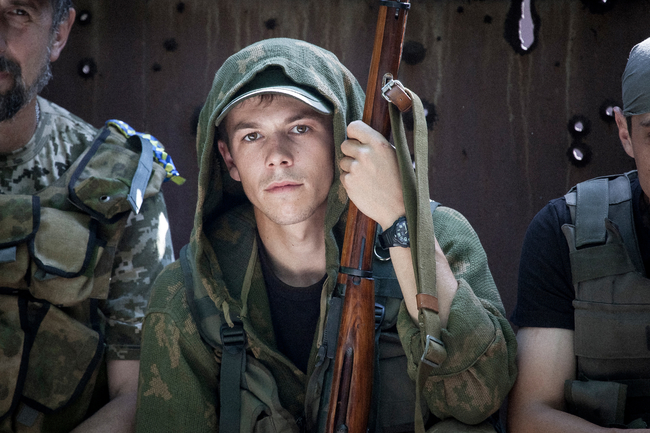“To have it etched on memory...”
Frontline photographer Yurii Velychko on the necessity of new perspectives
Yurii Velychko (nom de guerre “Photographer”) – is a soldier at the 46th Independent Special Purpose Battalion Donbas-Ukraine of the Ukrainian Armed Forces. He strove to go to war in the very first days but managed to do so as late as in early 2015. Demobilized in April 2016, he remained “in civvy street” for four month only and signed a service contract. A photo artist by vocation, Velychko combines performing combat missions with keeping the battalion’s photo and video chronicle. In October, five months after serving at the frontline, Yurii came back to the permanent location point in Lozova, Kharkiv oblast, and had an opportunity to take part in the photo competition and attend the opening of the 18th International Den’s Photo Exhibition. He did not return from it empty-handed – he received prizes from the Australian Embassy in Ukraine for his picture Nom de Guerre “Gal” and from the National League of Ukrainian Photo Artists for the picture Nom de Guerre “Pianist.”
Mr. Velychko, would you tell us about the pictures for which you received awards – Nom de Guerre “Pianist” and Nom de Guerre “Gal”?
“It has already been said and written very much about the ‘Pianist.’ Wherever we were, he would always look for and, what is more, find an instrument. This might be a club, a daycare facility, or a camp. The ‘Pianist’ would immediately begin to play. It was wonderful. This time we were stationed at a Sector A base. He was playing, when I crept and took a snapshot.”
“The ‘Gal’ is an artilleryman, but was adjusting the fire at the time. The photograph was taken in the summer at Marinka at the front side, for you can see a shot-through gate in the background. I took a group picture and then photographed each soldier individually. There was a spoil tip near that position, which was used as an observation point – you can see it on the photo Road of Cartridge Cases, also displayed at the Den’s photo exhibit. Soldiers climbed it once in a few days by turns. The enemy was trying hard to destroy this point – they fired with machine-guns, grenade launchers, and artillery. In a word, it was not exactly a bed of roses for those who were on this tip. The ‘Gal’ has already been demobilized and got married.

NOM DE GUERRE “PIANIST” / Photo by Yurii Velychko
“I constantly photograph and video-film in the course of service. I try to miss nothing important – I spotlight the battalion’s combat path, and the battalion is, above all, people, soldiers. For it happens that you’ve taken a photograph and it turns out a few days later that it was the last one for this man. This is why it is so important that all this remains in memory.”
What is the attitude of other soldiers to your work? There are perhaps those who are not willing to get into the lens...
“No. In contrast to the situation with photo correspondents, who come over for a day or two, soldiers always trust me. For a journalist, this is, above all, work. Whatever the case, he comes to the frontline, first of all, in order to make certain illustrations or footage for a news bulletin. But, for me, publication is secondary. The soldiers know that I will never show anybody in an unfavorable light. I’ve stayed at the battalion for long time now, so everybody knows what I do and take a positive view of this. I am grateful to them for this.”
Do you think the national media give adequate coverage of the war? This topic seems to have receded to the background as the hostilities have somewhat abated.
“It cuts both ways. If we speak too much, the war becomes commonplace and people no longer pay enough attention to it. Explosions, fire exchanges – every day the same. To arouse the interest of audiences, one must make materials of as high quality as possible. One must look for new perspectives. I think journalists should try to describe concrete stories instead of stooping down to the banal statistics of the killed and wounded. For they are the people who always stand next to me. And suddenly they get killed or crippled, as it happened with two of my comrades. We see all this differently – the viewer from his side and we from ours.”
Do you feel the rift in society between those who are involved in the war – the military and volunteers – and those who live a peaceful life?
“Of course. There are, unfortunately, also those who call it someone else’s war and say: let the oligarchs and Poroshenko do the job. They are doing their best to justify their non-involvement in not only the war but even in assistance efforts and sympathy. It is an easier option – let someone else fight, while I will live a life of my own here.”
What are your impressions of the Den’s photo exhibition?
“In two words, it’s strong and profound. Obviously, the photo exhibit was organized not for the sake of an exhibition as such, a report of sorts for the work done. No! I can notice a special approach. The pictures were selected in a careful and responsible manner. As a photographer, I know that it is not enough to make good pictures – it is also necessary to display them to advantage under good lighting. It was up to the mark, and I really liked it! I look forward to further cooperation and participation in the next photo exhibits.”
Newspaper output №:
№68, (2016)Section
Time Out





